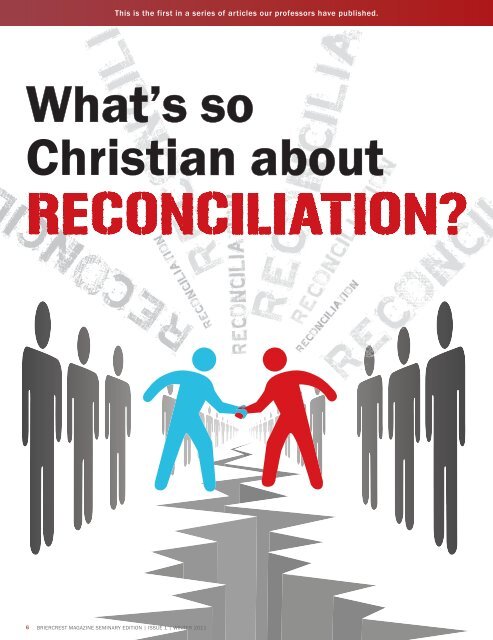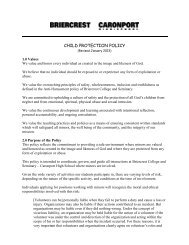Seminary Magazine edit.indd - Briercrest College and Seminary
Seminary Magazine edit.indd - Briercrest College and Seminary
Seminary Magazine edit.indd - Briercrest College and Seminary
Create successful ePaper yourself
Turn your PDF publications into a flip-book with our unique Google optimized e-Paper software.
This is the first in a series of articles our professors have published.<br />
What’s so<br />
Christian ian about<br />
This piece, written by Dr. David Guretzki, an<br />
associate professor of theology <strong>and</strong> the dean of<br />
the seminary at <strong>Briercrest</strong> <strong>College</strong> <strong>and</strong> <strong>Seminary</strong>,<br />
first appeared in Faith Today in May 2009.<br />
In recent years Canadians have<br />
heard much in the media <strong>and</strong> elsewhere<br />
about the need for reconciliation<br />
between Aboriginal peoples <strong>and</strong><br />
non-aboriginals, anglophones <strong>and</strong> francophones,<br />
<strong>and</strong> between families, spouses,<br />
<strong>and</strong> communities. Given the variety of<br />
ideas people have about reconciliation,<br />
what aspects of reconciliation fit with a<br />
specifically Christian approach Christians<br />
have always emphasized the need for reconciliation<br />
between God <strong>and</strong> humans. But<br />
we have not always been clear about how<br />
this biblical concept of “vertical reconciliation”<br />
relates to “horizontal reconciliation”<br />
between humans. The overlap may seem<br />
obvious, but let’s think carefully, starting<br />
with the undisputed champion of biblical<br />
texts on reconciliation: 2 Corinthians 5:15-<br />
21. We need to note at least three things<br />
from this text as we seek a biblical underst<strong>and</strong>ing<br />
of reconciliation.<br />
First, Paul insists that reconciliation<br />
is a completed <strong>and</strong> ongoing work of God.<br />
Paul speaks of it as having been already<br />
accomplished (“reconciled” in verse 18)<br />
<strong>and</strong> yet of God continuing to accomplish<br />
it right up to the present (“reconciling” in<br />
verse 19). Not only that, but God’s reconciliatory<br />
work is directed to both “us” humans<br />
<strong>and</strong> “the world.”<br />
Second, reconciliation is accomplished<br />
in <strong>and</strong> through Jesus Christ. Reconciliation<br />
to God is possible “through Christ”<br />
(verse 18), the one mediator between God<br />
<strong>and</strong> humanity. It’s also possible only “in<br />
Christ” (verse 19), in the Lord of creation<br />
<strong>and</strong> head of His body, the church. Consequently,<br />
Christians must always point to<br />
Jesus. We dare not try to take His place as<br />
“mediators,” but must fulfil God’s work as<br />
His “ambassadors” (verse 20).<br />
Third, reconciliation is to God the Father.<br />
Thus the Bible teaches it is only as<br />
“the world” is brought back into proper<br />
relationship to God the Father that reconciliation<br />
is ultimately fulfilled. So while our<br />
“ministry of reconciliation” (verse 18) necessarily<br />
includes<br />
working toward<br />
mending human<br />
relationships, such<br />
relationships can<br />
be fully healed by<br />
God the Father<br />
through the Son<br />
<strong>and</strong> by the Holy<br />
Spirit.<br />
The spiritual<br />
ministry of helping<br />
human enemies<br />
become friends<br />
(which is the core<br />
meaning of “reconciliation”<br />
<strong>and</strong><br />
Dr. David Guretzki<br />
“peacemaking”)<br />
is important, but it is not the final end.<br />
Rather, it is a means to the ultimate end of<br />
God befriending humans through Christ’s<br />
death for sin on our behalf (verses 14-15,<br />
21).<br />
This framework can remind us that any<br />
talk about human reconciliation, while<br />
always having the potential to be used<br />
by God for His purposes, can never quite<br />
capture the fullness of biblical reconciliation.<br />
For the Bible speaks of God’s coming<br />
kingdom of peace not only as the absence<br />
of all human conflict, but also as new <strong>and</strong><br />
transformed heavens <strong>and</strong> earth. There,<br />
redeemed humans will dwell together in<br />
communion with God by the merits of the<br />
Lamb (Revelation 13:8)! In this light we<br />
thank God wherever humans reconcile,<br />
but we also acknowledge that human reconciliation<br />
is a secondary “sign” of God’s<br />
primary work of reconciling all things to<br />
Himself (Colossians 1:20). In faith, we<br />
acknowledge that God’s kingdom is coming<br />
whenever we see reconciliation take<br />
place, however imperfectly accomplished.<br />
The relationship of vertical <strong>and</strong> horizontal<br />
kinds of reconciliation can be visually<br />
illustrated by paying attention to the<br />
cross-shaped nature of the Gospel. We<br />
can picture Jesus Christ at the very centre<br />
of the cross, where vertical <strong>and</strong> horizontal<br />
beams intersect. For it is through<br />
Jesus that God the Father reaches vertically<br />
down to redeem the world, yet it is<br />
also through Christ that God enables us to<br />
reach out horizontally as “co-workers” (2<br />
Corinthians 6:1) in fulfilling God’s purposes<br />
in the world. Thus we need to keep our<br />
eyes fixed on Him who endured the cross,<br />
both for the sake of God’s glory <strong>and</strong> for our<br />
salvation (see Hebrews 12:1-2).<br />
A visual image of the cross can also<br />
remind us that the vertical beam is the<br />
one upon which the horizontal beam is<br />
hung. Consequently, as much as Christians<br />
should be the first to applaud efforts<br />
to reconcile alienated human parties, we<br />
must remember that human efforts at reconciliation<br />
are ultimately for naught if we<br />
fail to implore people, as Paul dem<strong>and</strong>s,<br />
to be reconciled to God (verse 20). In other<br />
words, reconciliation among neighbours is<br />
an integral part of a “cross-shaped” Gospel,<br />
but there is no cross <strong>and</strong> no true reconciliation<br />
if the vertical beam of reconciliation is<br />
somehow ignored or forgotten. The horizontal<br />
beam cannot hang in mid-air, unsupported by<br />
the vertical!<br />
6 BRIERCREST MAGAZINE SEMINARY EDITION | ISSUE 1 | WINTER 2011<br />
WWW.BRIERCREST.CA<br />
7
















